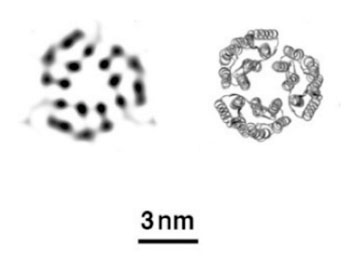Superbright, Fast X-Rays Can Visualize Just One Layer of Proteins
By LabMedica International staff writers
Posted on 24 Feb 2014
Scientists are now using exceptionally bright and fast X-rays that can capture an image of a protein that rivals traditional techniques with a sheet of protein only one protein-molecule-thick.Posted on 24 Feb 2014
A protein’s shape is crucial for understanding how it causes disease or toxicity. Researchers who use X-rays to take images of proteins need a billion copies of the same protein stacked and packed into a well-ordered crystal.

Image: X-ray free-electron lasers (XFELs) can create images (left) that accurately reflect the known structure of proteins determined by conventional methods (right), in this case, three bacteriorhodopsin proteins (Photo courtesy of DOE/Pacific Northwest National Laboratory).
Using a type of laser known as the X-ray free electron laser (XFEL), the technique creates ways to determine the structural characteristics of nearly 25% of known proteins, many of which have been missed because of their inability to stack effectively. The team of researchers led by the US Department of Energy’s (DOE) Pacific Northwest National Laboratory (PNNL; Richland, WA, USA) and Lawrence Livermore National Laboratory (LLNL; Livermore, CA, USA) reported their findings with this innovative type of X-ray diffraction in the March 2014 issue of the International Union of Crystallography Journal. “In this paper, we’re proving it’s possible to use an XFEL to study individual monolayers of protein,” said PNNL microscopist Dr. James Evans. “Just being able to see any diffraction is brand new.”
Dr. Evans is co-leader of the team of two dozen scientists with LLNL physicist Dr. Matthias Frank. The bright, fast X-rays were produced at the Linac Coherent Light Source (LCLS) at the SLAC US National Accelerator Laboratory (Menlo Park, CA, USA), the newest of DOE’s major X-ray light source facilities at the national laboratories. LCLS, currently the world’s most powerful X-ray laser, is an X-ray free-electron laser. It generates beams millions of times brighter than earlier X-ray light sources.
At approximately 0.8 nanometer resolution, the proteins appear somewhat fuzzy but match the predicted view based on earlier studies. Dr. Evans reported that this degree of clarity would allow researchers, in some instances, to visualize how proteins alter their shape as they interact with other proteins or molecules in their environment.
To obtain a better view of protein monolayers using XFEL, the scientists will need to enhance the resolution to 0.1 to 0.3 nanometers, as well as capture images of the proteins at different angles, efforts for which are currently ongoing. Researchers have been using X-ray crystallography for over 60 years to determine the shape and form of proteins that form the inner workings of a living organism’s cells. The conventional technology requires, however, that proteins stack into a large crystal, similar to how oranges stack in a crate. The structure of more than 80,000 proteins have been determined this way, leading to a better understanding of diseases, pathogens, and how organisms grow and develop.
However, many proteins found in natural surroundings do not stack easily. Some protrude from the fatty membranes that cover cells, identifying and interacting with other cells and objects, such as bacteria or viruses, in the surrounding area. These proteins are not used to having others of their kind stack on top. These membrane proteins comprise approximately 25% of all proteins but only 2% of proteins for which researchers have determined structures.
Researchers in the last 10 years have been pursuing the theory that one sheet of proteins could be visualized if the X-rays were bright enough but flashed on and off swiftly enough to limit the damage brought about by the powerful X-rays. Researchers, two years ago, demonstrated they could use XFEL technology on crystals of proteins approximately 15 to 20 sheets thick.
The scientists needed to push this further and worked on a way to create one-sheet-thick crystals of two different proteins: a protein called streptavidin and the membrane protein bacteriorhodopsin. The structures of both proteins are well known to scientists, which gave them something with which to compare their findings. The scientists shined the super-bright X-rays for about 30 femtoseconds on the protein crystals. They created so much data in the process that it took them more than one year to study all of it.
The resulting images look like the known structures, confirming that this technology works. Next, the researchers will try to capture proteins changing shape as they engage in a chemical reaction. For this, even shorter flashes of X-rays might be needed to see the action clearly. If effective, shorter flashes of XFEL might mean longer lines at SLAC.
Related Links:
Pacific Northwest National Laboratory
Lawrence Livermore National Laboratory




 assay.jpg)








